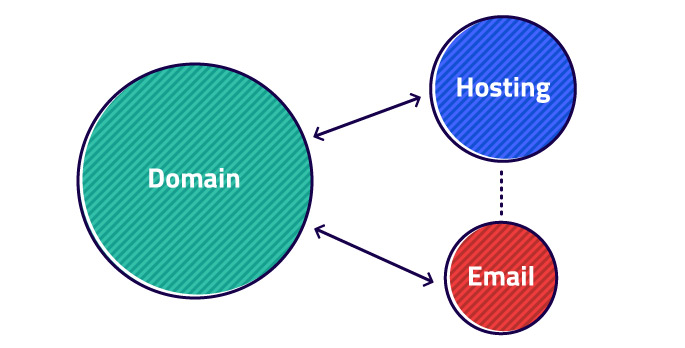Depending on the size of your business and the complexity of your website, setting up a new domain, as well as hosting and email servers can either be a piece of cake or a major nightmare that can cost your brand dearly. If you run a small business, you may be able to get by with a service like Wix.com or other one-size-fits-all services that are similar. However, if your business has desires on reaching the Fortune 1000 or at the very least growing beyond Mom and Pop status, don’t even think about doing it on your own. If you get it wrong, you may not only pay the price in time wasted and money spent, but you could also open yourself up to identity theft via the WHOIS database.
Obtaining and assigning the proper IP addresses and inserting them into the correct form fields in the back-end of your web, hosting and email servers can be complicated. It’s not something that should be undertaken by someone with no experience because one false step and you could find yourself in Migraine City.
In this article, we will explain the three main components you or your hired team need to address when setting up a new website for your new brand or business, as well as the final step which is required to help them communicate seamlessly.

1. Purchase your domain name or URL
The domain name can be purchased from one of many providers (also called “registrars”) such as NameCheap, Network Solutions or GoDaddy, among others. You can perform a URL search with any of these providers to see what names and suffix combinations are available. Many basic “.com” names have already been taken so you will need to be creative, patient and perhaps also willing to utilize alternative suffixes in order to obtain shorter “URLs” for your brand. Trillion offers domain name development services as a part of our website design projects so you may also want to reach out to us for help with your domain name creation.
Another nice feature that these registrars have on their domain name search tools is the ability to search multiple names at one time. They also offer suggestions utilizing similar words or alternative suffixes. We recommend NameCheap to our clients. It is less expensive and the renewal fees are more reasonable when compared to GoDaddy, for example. Either way, you should pay the registrar no more than $20 per year, on average, to own the domain.
The fees to purchase domain names range from $3 to $20 per year – more for some specialized suffixes, which may not be available to you anyhow unless your business or service meets certain qualifications. Keep in mind that Google search looks favorably upon website URLs which are registered for several years or more. Since the cost is so low, we recommend registering for at least 5 years. Auto renewal settings can keep your credit card information on file and automatically renew your domain name to avoid down time if your registration lapses. Should you decide not to auto renew don’t worry, your registrar will give you plenty of notices and months of lead time to renew as your end date approaches.
In addition, some registrars waive the cost of the domain name registration for the first year if you also purchase hosting from them. If you are having your web designer or web developer purchase the URL for you, insist that everything be registered in your company’s name and that you are provided all of the user name and login credentials.
Once you find a domain name that works for your brand, don’t delay, purchase it! We have had clients delay purchasing a domain name only to find that another person swooped in and registered it before them!
Do I Need to Purchase Domain Name Privacy?
When you register your domain name, you will have the opportunity to purchase domain name privacy. The annual fee varies from less than $3 to $15 with some registrars providing it the first year for free. When you choose the privacy option, the contact information of the person who owns and manages the domain name, including name, address, phone number and email address will be hidden. Domain Name Privacy is another feature that can be set to auto renew. Trillion does not utilize domain name privacy but many of our clients prefer to, especially when it’s an individual registering the domain rather than a business.

2. Purchase website hosting for your brand
Hosting can be a tricky choice depending on what you will be doing on your website and how much traffic your website will potentially receive. There are a lot of hosting providers available and many are repackaged or private label services of larger hosting companies. Consider your situation before making a decision:
- For many small to medium sized businesses, basic or intermediate website hosting on a shared server will be sufficient. The cost per month can be less than $5 when paying a few years in advance—which is what Trillion recommends doing. Like just about anything else, the longer you commit the lower the fees you’ll pay on average per month.
- If you expect your website will handle a lot of traffic each month or if it has database-intensive features, you will achieve faster performance by using a virtual private server (VPS) or dedicated hosting server. This will optimize the user experience on your website and allow for faster data calls and loads. With these servers, however, you can expect a higher monthly fee starting at about $30 for a VPS or $130 for a dedicated server.
- If your website expects explosive web traffic – let’s imagine you run an ad during the Super Bowl – there are services such as Amazon’s Elastic Compute Cloud (Amazon EC2) which allow you to quickly scale capacity, both up and down, as your website traffic demands change. A service like this can be your most expensive option as it is charged by time and server speed bandwidth usage. A service like this can easily cost thousands of dollars per month.

3. Purchase your email hosting
You always have the option of paying the same provider for domain name registration, website hosting and branded email hosting. However, many business owners like the flexibility of using cloud and web-based services such as Google Apps, where much of their data and email are hosted. Microsoft Exchange is another very popular service that keeps multiple devices synced together no matter where a user is located, as long as they have access to an internet connection.
Naturally, email hosting services require yet another monthly fee. The fees are based upon the number of users (i.e. email addresses) and can range from $4 to $10/month per mail box.
4. Now, let’s make your web, hosting and email “talk” together!
Connecting all of your providers requires that your IP addresses that route data from one server to another are assigned correctly so everything works seamlessly.
With so many settings and variables, we highly recommend hiring an IT professional to set up everything right the first time. When you make changes to these website connections and email servers, a “propagation” period is often required before the changes show up on the web. Propagation refers to the time it takes for other servers on the web to notice changes on your server. It can take a few seconds, minutes or a few hours to display the correct information across the web. Because your business depends on it, it’s best to let a professional handle these IP assignments so your website and email accounts work as they’re supposed to. Trillion’s IT pros have made many of our clients’ lives easier by handling all of these back end services. We can do the same for you, too.
5, 4, 3, 2, 1…
Once everything has been set up and tested, your website is ready to go! At Trillion, our clients regularly ask us to purchase, setup and take care of these connectivity issues as part of our website design and development activities. Rest assured, we always share user names and login credentials with our clients and all accounts are set up in your name. In addition, for your security, we do not host multiple clients on our servers. If you would like Trillion to design, develop and take care of all the IP issues that impact your website, contact us or call 908.219.4703.









